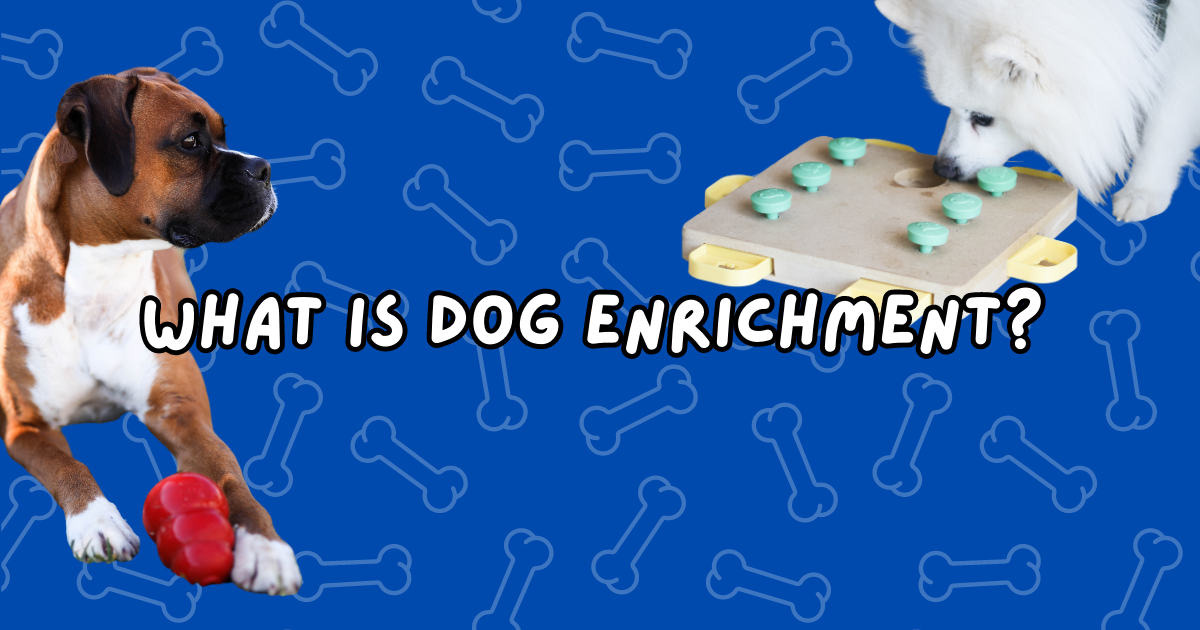What is Enrichment for Dogs?
Enrichment plays an instrumental role in the mental, physical, and emotional well-being of dogs. This blog post delves into what enrichment is, why it is important, and the different types of strategies that can be employed. We often see enrichment touted as an opportunity to take a break from your dog; something to babysit them. While we all need alone time, we love to think of enrichment as an opportunity to strengthen your bond with your dog further. We think this slight perspective shift can profoundly impact humans and their furbabies.
What is Enrichment?
Enrichment means activities that allow dogs to engage in natural and innate behaviors like chewing, playing, scavenging, chasing, smelling, and exploring their different senses. These activities allow them to be physically and mentally stimulated. As enrichment activities should be rewarding and valuable to each dog, they may look different for everyone.
The key to enrichment is ensuring it’s valuable to your dog. If your dog isn’t able to use the item, is afraid of it, or is bored with it; it’s not all that enriching. It’s essential to tailor enrichment activities to the needs and preferences of each individual dog.
Why is Enrichment Important for Dogs?
Enrichment serves to reduce stress, provide mental stimulation, and reinforce socialization practices. Giving your dog opportunities for enrichment allows them to have a sense of control over their environment. This helps to build confidence, can reduce destructive and unwanted behaviors, like excessive barking and chewing.
Types of Enrichment
Enrichment for dogs comes in so many shapes and sizes. We love that it’s an opportunity to be creative while having fun with our pups.
Our favorite source of inspiration is the Canine Enrichment Ideas Facebook Group.
While there are endless possibilities for dog enrichment activities, there are 5 main types of enrichment:
Food or Nutritional Enrichment
Activities that encourage dogs to use natural foraging and feeding behaviors to earn food.
Hiding food and allowing them to search for it
Alternating feeds, treats, and chewable items
Scatter feeding
Social Enrichment
Activities that promote social interaction with other dogs and species, including humans.
Supervised playgroups
Going on walks
Meeting new people
Multiple dog household interactions
Playing, praising, petting, and spending time with your dog
Occupational Enrichment
Giving a dog a regular activity, aka ‘job’ that provides physical and mental stimulation.
Sports such as agility, flyball, fetch
Positive reinforcement training/learning tricks
Dog jumping through an agility ring (occupational enrichment)
Sensory Enrichment
Activities that stimulate that dog’s different senses, such as sight, sound, or smell.
Scent training and games
Exposure to music
Putting scents in a dog’s pen
Physical Enrichment
Providing a quality and involved living space.
Safe toys
Rotating toys to maintain novelty
Adding physical features to a backyard, pen, or run
Adding a ramp or steps to access the bed or couch
Providing a bed, crate, or place
Dog enrichment is more than just a way to keep your dogs entertained; it’s a comprehensive approach to enhancing their overall well-being. By providing these opportunities for enrichment into our dog’s daily routines, we’re strengthening our bond with them, improving their quality of life, and ultimately making them healthier and happier.




